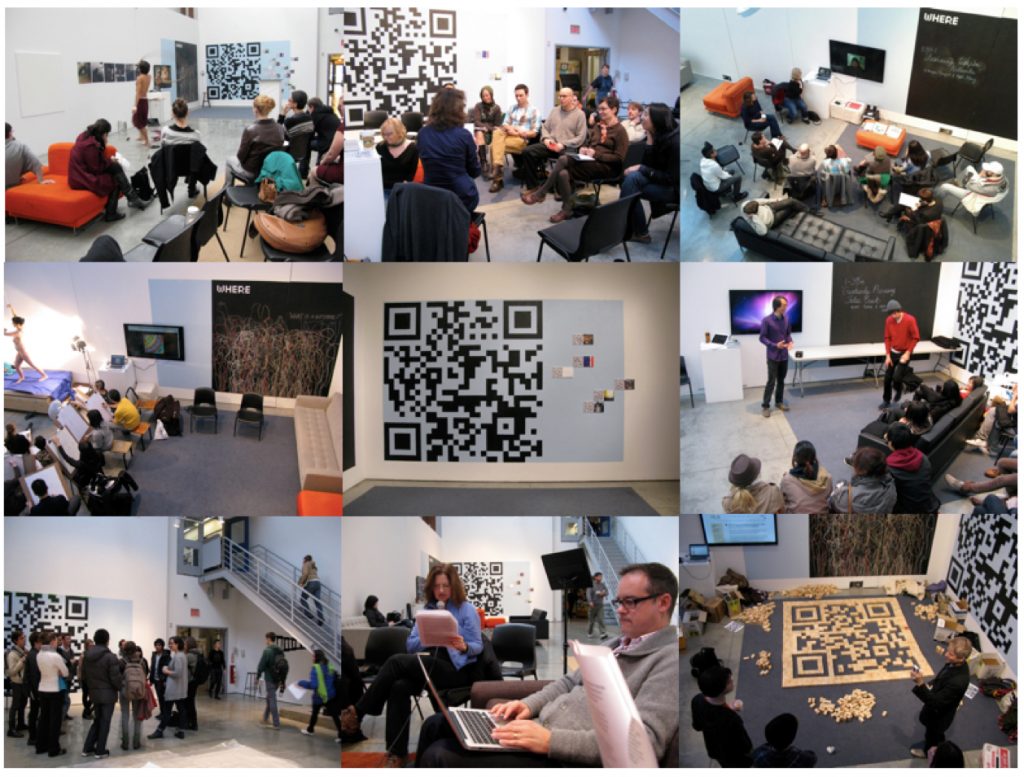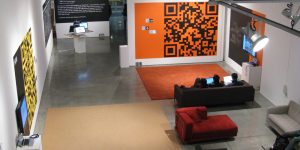QR_U (an open school) is an interactive exhibition project I created with fellow artists Lois Klassen, Elisa Yon, and Adam Stenhouse. The project existed as a 10-day school-within-a-school at Emily Carr University of Art & Design in December, 2011.
The project presented participants with a series of questions about their relationships with the arts, learning, and technology in order to generate dialogue through conversation, imagery, video, and text. The range of questions and ideas stemmed from three overarching themes: What is the new school of the arts? Where does learning happen? and, How can we learn to learn?
Participants could contribute to the ongoing dialogue in the ‘virtual school’ at http://qruopenschool.ca and within the physical space of the gallery by taking part in a series of events. The media and events in the gallery space were instigated by questions and responses generated at the QR_U virtual school, which continues to exist online indefinitely at the website listed above.

‘QR’ in the project title is a play on the abbreviated form of QR code, which actually stands for Quick Response. This project aimed to create an occasion for experimenting with and moving beyond the quick response. Participants were invited to access the website questions in the gallery by using the computer stations and by scanning the small and large QR codes. exhibition images submitted to the website were mounted on the gallery walls. If a visitor scanned its adjacent QR code, he or she would be taken to the question that the image responded to. That individual could then choose to post a response.
We intended to make visible the inside of an open school and to build a culture of exchange and dialogue – with multiple entry and exit points. The term ‘open school’ was used as a way of initiating an ongoing process of network relations that could be understood as an overlapping experience of art, teaching, and learning. The public gallery space was transformed into three open classrooms where events and discussions situated the project’s larger questions. QR_U brought together experimental approaches to teaching and learning and art practices that explore processes of knowledge, which contributed to the dialogical, collaborative and performative events that emerged. The project aimed to create an occasion and a setting to think about the future of the art school. It was a social experiment and “a really transformative way of providing context for debate…It became a place where people stopped and listened” [1]
While events occurred daily in the physical space of QR_U, conversations continued in the virtual school. As image, video, and text responses were submitted, a multimedia and networked archive began to grow.
Flickr photos >
Facebook community >
Twitter feed >
Vimeo videos >
Bookmarks + Resources >
QR_U was conceived in conjunction with and response to the 2011 ELIA Leadership Symposium - W/HERE: Contesting Knowledge in the 21st Century.
Community and public participation was intended to both challenge and inform the ideas being discussed by current leaders of higher arts education.
Project development involved gaining interest and participation from local faculty and students as well as those from the UK, Germany, Finland, United States, and across Canada.

The components of QR_U existed as a combination of social, aesthetic, and durational forms arranged to create an embodied discourse around art and education. The intervention of the gallery space challenged the traditional notion of an exhibition by producing a networked space of relational learning. The physical spaces were constantly rearranged to elicit conversation and dialogue amongst participants. Questions and responses to the virtual conversations were transmitted back to the physical space in a successive manner, ultimately producing a feedback loop between the captured responses on display and knowledges obtained and contested.
The QR_U project was conceived over several months of conversations with fellow artists and was never intended to be analysed as a form of research. With QR_U I was able to let go of a required research model and become engaged in the process of network art as a medium of relational learning and pedagogy. Through close analysis, however, I was able to better comprehend the dialogical, collaborative, and performative aspects of network art/learning/teaching that involves art and technology in ways that move beyond digital.